Tall & Flaky Buttermilk Biscuits
Discover the secret to tall, flaky, buttery buttermilk biscuits with this easy homemade recipe. They are wonderful on their own, with a smear of butter or jam, or as a base for sausage gravy, strawberry shortcake, or your favorite breakfast sandwich.
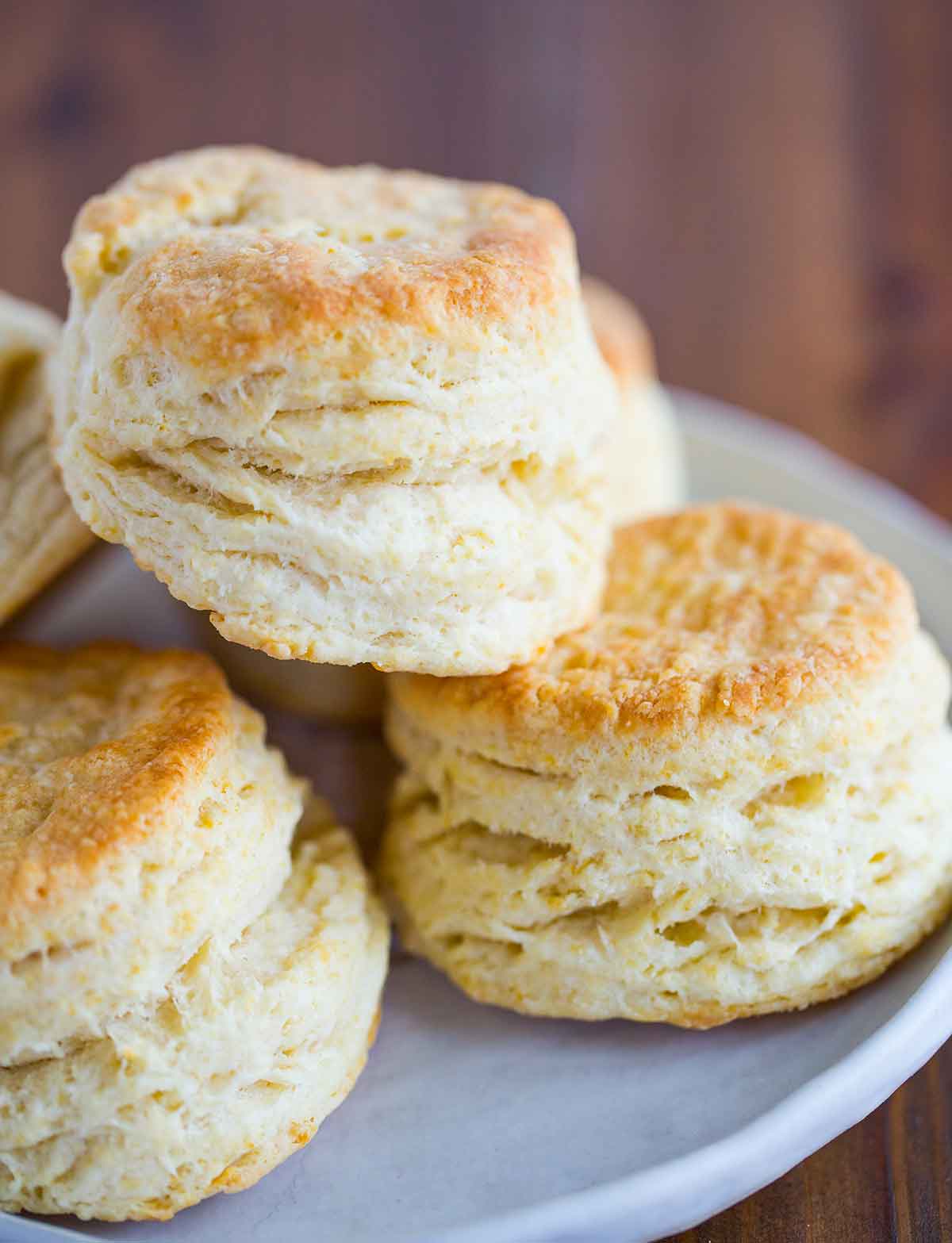
The buttermilk biscuit recipe I had made for the better part of my adult life was always fine, but most definitely not phenomenal. They were good, but not mind-blowing. I wanted sky-high biscuits with tons of buttery layers, and I'm thrilled to tell you that they are HERE. With just a few tweaks and simple tricks, I had the biscuits of my dreams.
There's just something magical about pulling apart that soft biscuit, watching the steam wisp out of the middle, and then savoring each buttery, flaky layer.
I can now enjoy sausage gravy and strawberry shortcakes with reckless abandon!
Ingredient Notes on Buttermilk
Biscuits are one of the simplest baked goods that you can make as they mostly use kitchen staples like flour, sugar, salt, and butter, but they include one special, important ingredient – buttermilk. I try to always have a quart in the refrigerator for pancakes, waffles, biscuits, or any other delicious recipe that calls for it.
It plays a vital role in biscuits due to its acidity, which reacts with the baking powder to give biscuits an incredible lift; it’s how we get those nice, tall biscuits with a fluffy texture. Due to the power of its acidity, you can’t simply use regular milk in its place. Here are a few notes on how to deal with substitutes and how to store extra:
How To Make Buttermilk if You Don't Have It
If you don't have buttermilk on hand, you can easily make it using a combination of regular milk and either lemon juice or white vinegar (this is referred to as "clabbered milk"); here's how to do it:
Add 1 tablespoon of lemon juice or white vinegar to a measuring cup, then add enough milk to make 1 cup. Stir together, then use as directed in the recipe. (You can scale up if needed; if you do not need a full 1 cup, discard what you do not need.)
How To Tell if Buttermilk Has Gone Bad
Since buttermilk already has a characteristic sour smell and taste, and it can take a long time for it to actually get moldy, it can be difficult to tell if it has gone bad. And because it is acidic, it will take a long time to actually develop mold.
Buttermilk should typically be used within a couple of weeks of opening it, but if you shake it up and the consistency is "off" from when it was originally opened (super thin or extra chunky), then discard it. Also, if it emits a more foul odor than the traditional sour smell, then pitch it as well.
Freezing Buttermilk For Later Use
Most recipes don't call for more than 1 cup of buttermilk at a time, so I've found the best and most efficient way to freeze buttermilk is in 1 ounce (2 tablespoon) portions.
To do this, I love these silicone ice cube trays (also perfect for storing leftover adobo peppers and sauce if you make my chipotle chicken recipe) - once frozen, I pop them out and store in a freezer ziploc bag until I need them. Thaw in the refrigerator, then whisk well to reincorporate the buttermilk, which will separate when frozen.
You can store the frozen buttermilk for up to 3 months.
How to Make Super Flaky Biscuits
Biscuits are very straightforward to make (people have been making them for at least hundreds of years!), but I discovered one key technique that helps to create super fluffy, flaky biscuits. Here’s how I make them:
Step #1: Make the Dough – Combine flour, baking powder, and salt in a small bowl. Cut the butter into the dry ingredients using a pastry cutter or two knives (you can even do this in a food processor with a handful of quick pulses, if you’d like). Using a fork or rubber spatula, stir the buttermilk into the flour and butter mixture, mixing until a soft, slightly sticky ball forms.
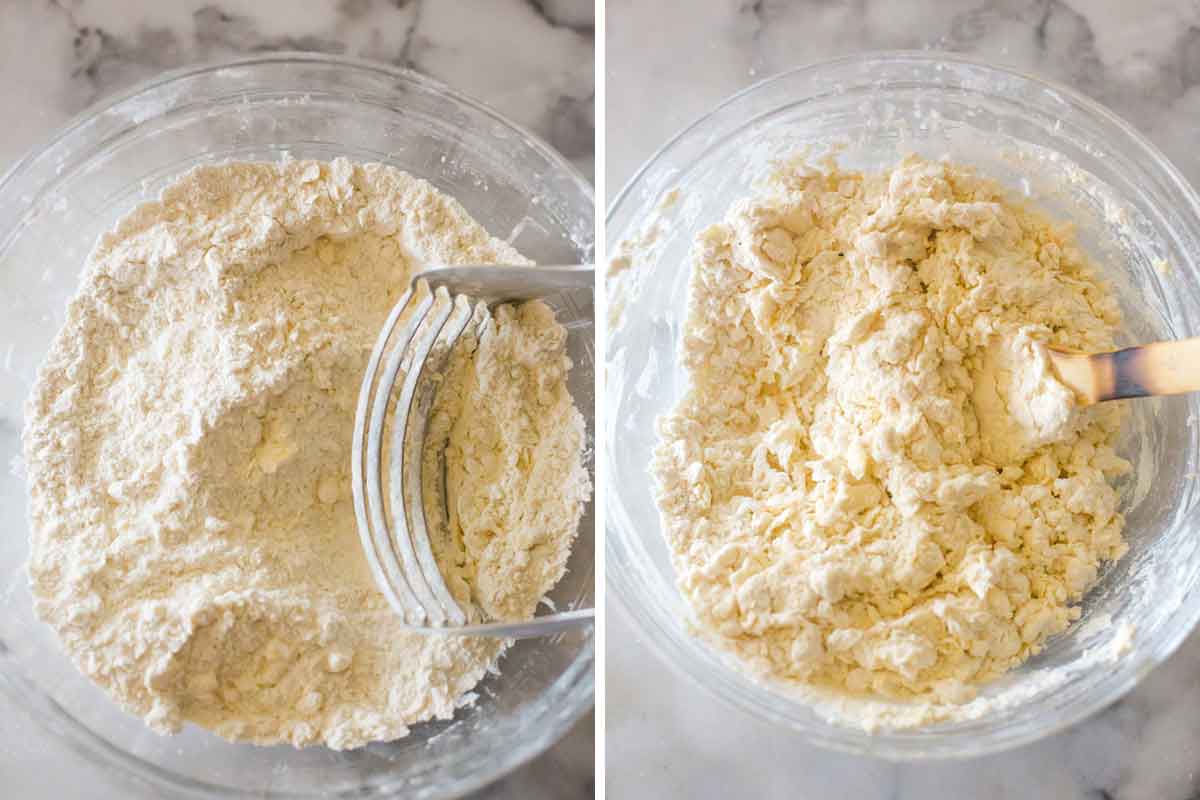
Step #2: Fold the Dough – Turn the dough onto a lightly floured surface and quickly form into a rough square. Pat the dough into a 1-inch-thick rectangle. Fold the dough letter-style into thirds, then lightly pat the dough back out into another 1-inch rectangle. Try to handle the dough as quickly and lightly as possible. Repeat the folding 2 more times; after the final fold, press or lightly roll the dough into a ½-inch thick rectangle.

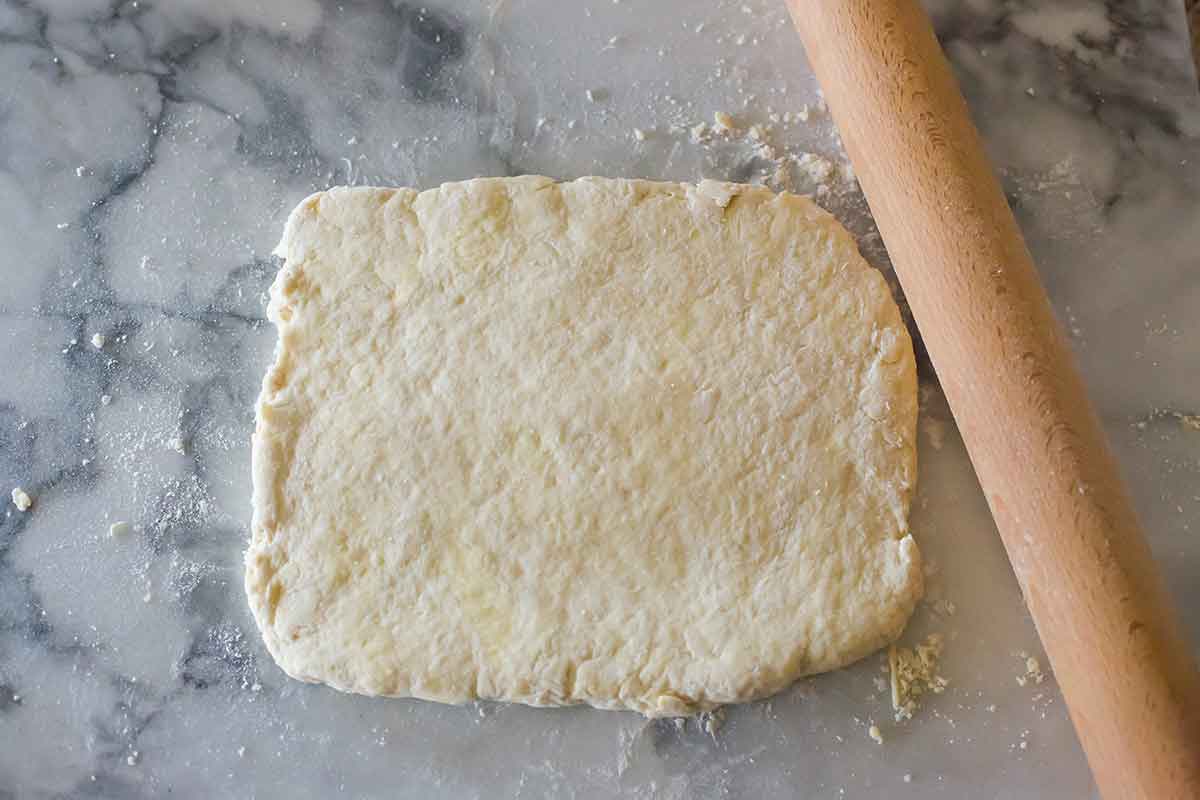
Step #3: Cut Out the Biscuits – Using a 2½-inch round biscuit or cookie cutter, cut out the dough rounds and place them on a parchment-lined baking sheet. Pat and roll the remaining scraps to cut out more rounds.
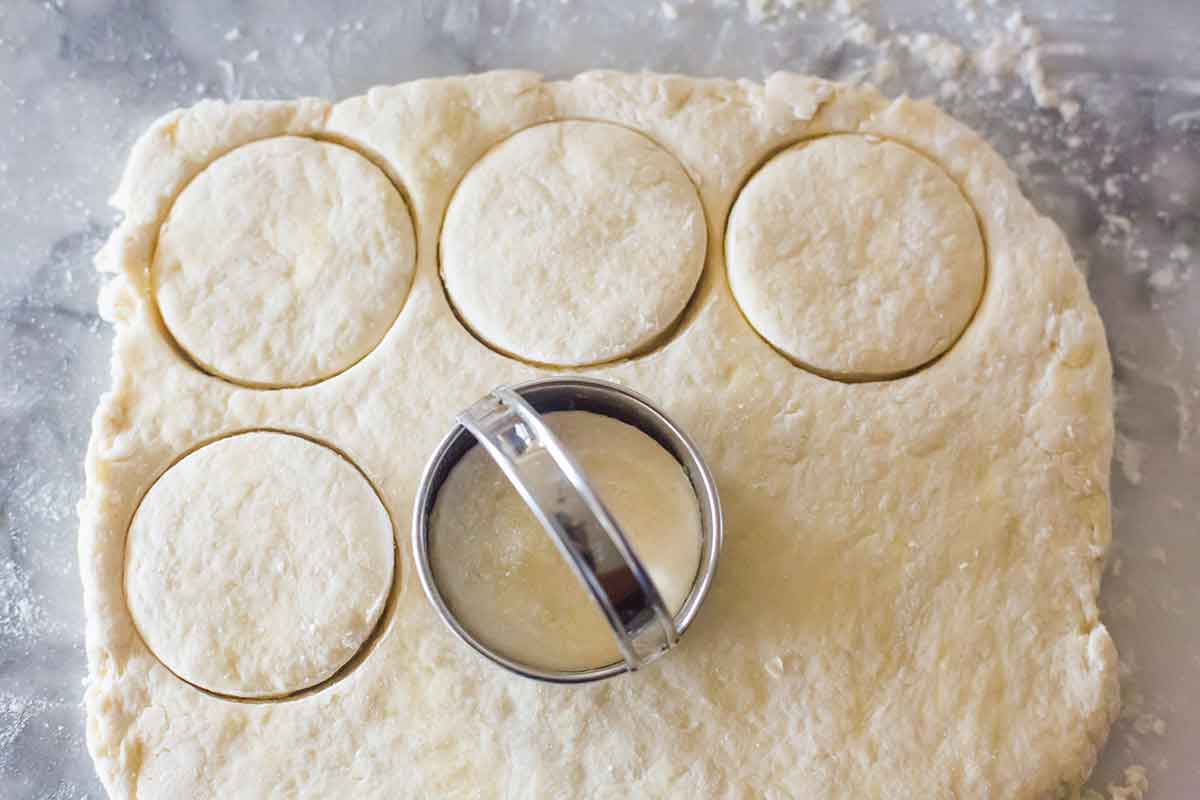
Step #4: Bake the Biscuits – Brush the tops of the biscuits with melted butter and bake until the biscuit tops are light golden brown, 10 to 15 minutes. Brush with additional butter (or honey butter!) immediately, if desired.
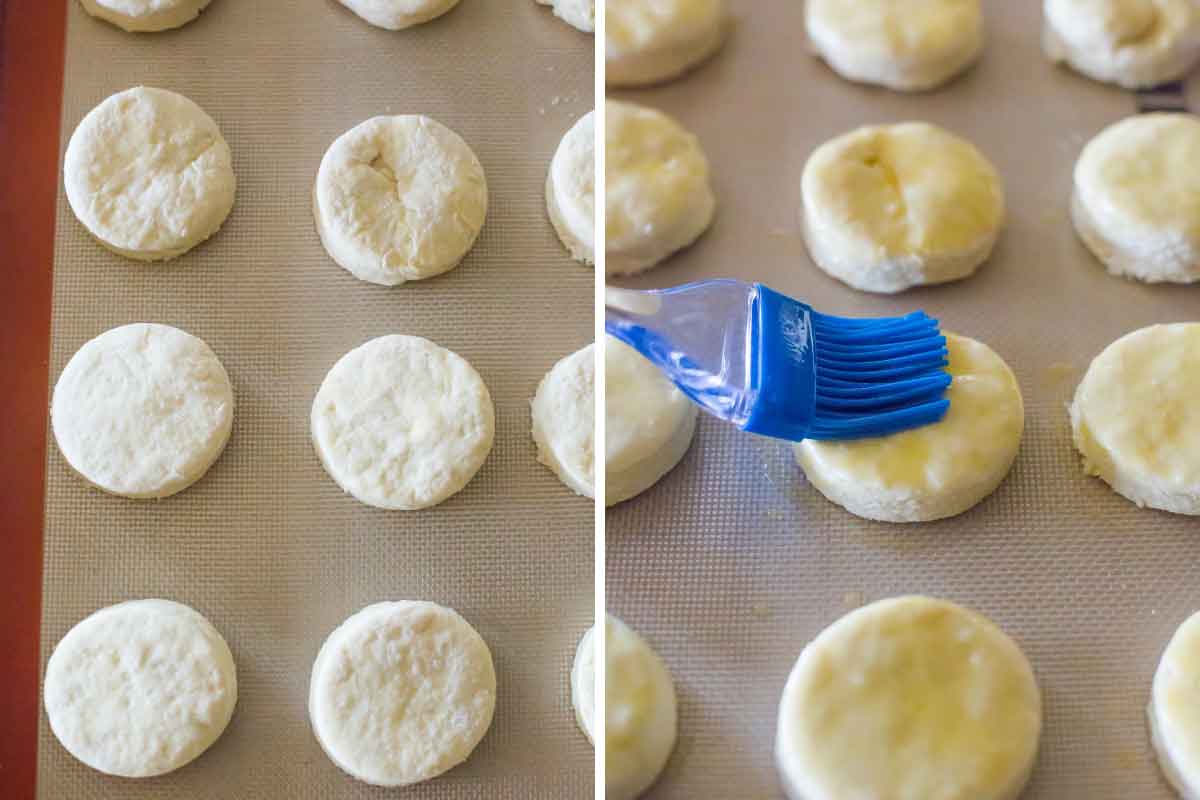
Making the Biscuits in a Cast Iron Skillet
This is a great option if you love the bottom of your biscuits to have a little crisp and crunch to them!
Simply place the biscuits in a large cast iron skillet, leaving a little space between each one so that they have room to grow and rise.
Can Buttermilk Biscuits Be Made Ahead of Time?
To prepare the biscuits ahead of time without baking them first, you can simply prepare the dough and cut out the biscuits, then place on a parchment-lined baking sheet, cover with plastic wrap and place in the freezer. Once completely frozen, place the biscuits in a freezer ziploc bag and keep in the freezer for up to 3 months.
When ready to bake, place the frozen biscuits (no need to thaw!) on a parchment-lined baking sheet and bake at 425 degrees F for 20 to 25 minutes.

Storing and Reheating the Biscuits
While biscuits always taste best fresh from the oven or the same day they are made, you can store any leftover biscuits in an airtight container at room temperature for up to 3 days.
To reheat leftover biscuits and get the fresh-from-the-oven flavor and texture, I recommend reheating in a 350-degree oven (a toaster oven is perfect for this, too!) for about 5 minutes. Perfection.
Freezing Already-Baked Biscuits
If you’d like to store some of the biscuits you’ve already made in the freezer, you can do that, too! Make sure that they have cooled completely, then wrap each biscuit tightly in plastic wrap and place in a freezer-safe ziploc bag or other airtight container. They will keep well in the freezer for up to 3 months.
You can thaw the frozen biscuits at room temperature or (the better option, in my opinion!) reheat them in the oven. Simply place the frozen biscuits on a parchment-lined baking sheet, cover lightly with foil, and heat at 350 degrees for 15 to 20 minutes, or until soft and warm in the center.
Key Recipe Tips!
Biscuits are one of the simplest baked goods to make, in terms of both ingredients and time, but they have been known to cause even the most even-tempered bakers to pull their hair out.
Light, fluffy biscuits and hockey pucks are separated by a very fine line. Below are some tips to help make sure you end up in fluffy biscuit land, and not on ice…
- Cold butter is key. For biscuits (as well as pie crusts) I find that cubing the butter and then putting it on a plate in the freezer for about 15 minutes before using it keeps it nice and cold while mixing. Some people also swear by grating frozen butter; whatever method you use, the most important part is that it is freezing cold when you start!
- Mixing the butter and dry ingredients quickly so the butter remains cold and firm is crucial to producing light, tender biscuits. The dough will likely be shaggy and rough, and that's okay; if you work it until it's smooth, it will be overworked and result in tough biscuits. A light touch and little pressure are important.
- Folding the dough envelope-style is the biggest difference I've found when re-working my biscuit recipe. It creates incredibly tall biscuits with layer upon flaky layer of buttery goodness.
- When you cut the biscuits, whether with a cookie cutter or biscuit cutter, push straight down, then pull right back up. DO NOT twist the cutter… I used to make this mistake and couldn't believe the difference it made when I stopped!
- The intense heat of the oven creates the steam needed to raise the dough and create airy, fluffy biscuits. Make sure your oven is completely preheated before baking the biscuits.
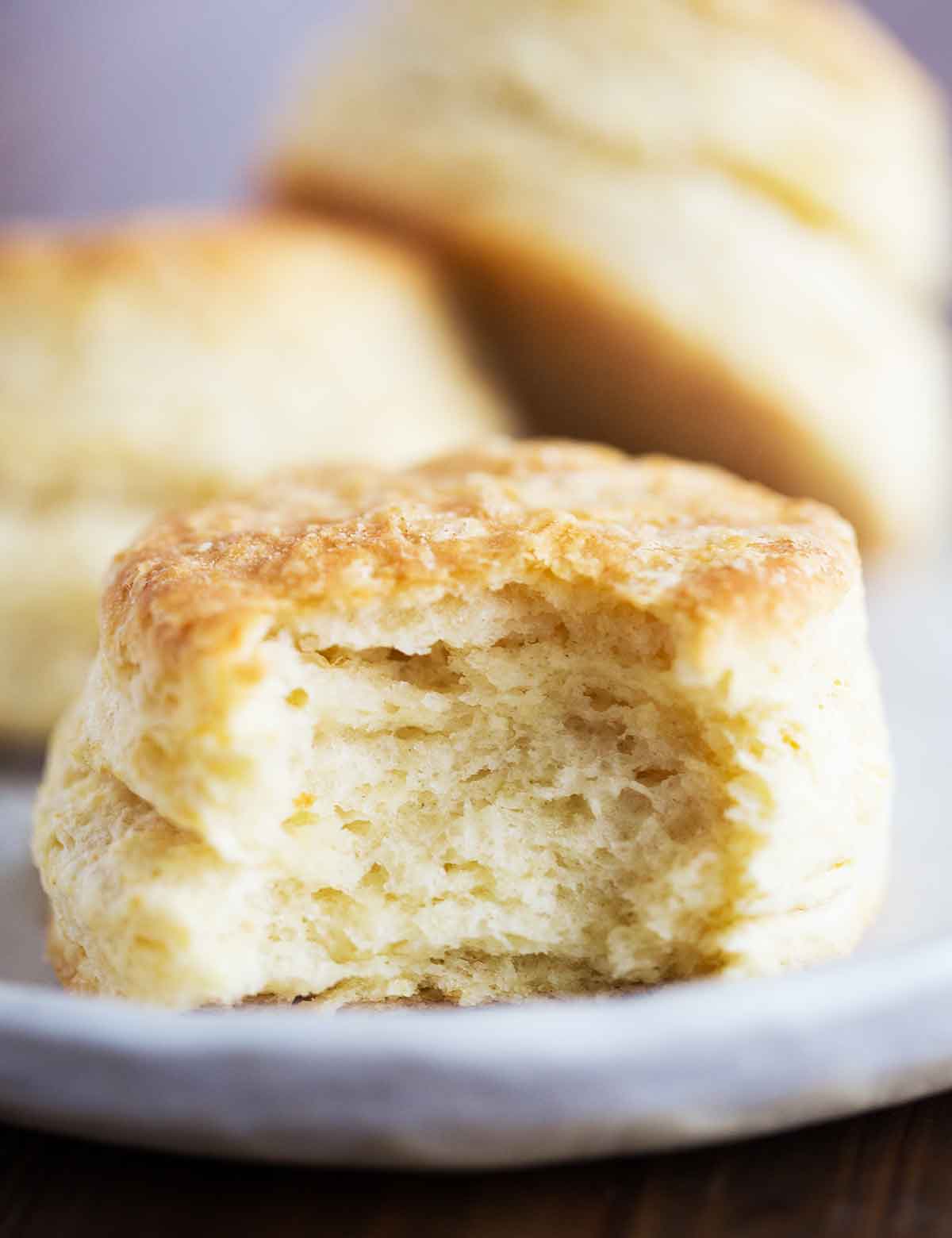
If You Love Biscuits, Make These Recipes Next:
- Southern-Style Biscuits and Gravy
- Homemade Strawberry Shortcake
- Sausage-Cheddar Biscuits
- Red Lobster Cheddar Bay Biscuits
Watch How to Make Buttermilk Biscuits:
If you make these buttermilk biscuits and love them, remember to stop back and give the recipe a 5-star rating - it helps others find the recipe! ❤️

Buttermilk Biscuits
Ingredients
- 2½ cups (325 g) all-purpose flour
- 2 tablespoons baking powder
- 2 teaspoons granulated sugar
- 1 teaspoon salt
- ½ cup (113 g) cold unsalted butter, cut into ¼-inch cubes
- 1 cup (240 ml) cold buttermilk
- ¼ cup (57 g) unsalted butter, melted, for brushing
Instructions
- Preheat oven to 425 degrees F. Line a baking sheet with parchment paper or a silicone baking mat.
- In a large bowl, whisk together the flour, baking powder, sugar and salt.
- Using a pastry blender (or two knives or your fingertips), quickly cut the butter into the flour mixture until the mixture resembles coarse meal with a few slightly larger butter lumps.
- Using a rubber spatula or fork, stir in the buttermilk until the mixture forms a soft, slightly sticky ball.
- Transfer the dough to a lightly floured surface and quickly form into a rough square. Be careful not to overmix. Pat the dough into a 1-inch-thick rectangle. Fold the dough letter-style into thirds, then lightly pat the dough back out into another 1-inch rectangle. Try to handle the dough as quickly and lightly as possible. Repeat the folding 2 more times; after the final fold, press or lightly roll the dough into a ½-inch-thick rectangle.
- Using a 2½-inch round biscuit or cookie cutter, cut out the dough rounds and place on the prepared baking sheet. Pat and roll the remaining scraps to cut out more rounds. Brush with the melted butter and bake until the biscuit tops are light golden brown, 10 to 15 minutes. Brush with additional butter immediately, if desired. Serve warm or at room temperature. The biscuits are best served the day they are made, however leftovers can be stored in an airtight container at room temperature for up to 4 days. Reheat in a 350 degree F oven for 5 minutes.
Notes
- Buttermilk – If you don’t have buttermilk, mix together your own using this method: Add 1 tablespoon of lemon juice or white vinegar to a measuring cup, then add enough milk to make 1 cup. Stir together, then use as directed in the recipe.
- Storing – While biscuits always taste best fresh from the oven or the same day they are made, you can store any leftover biscuits in an airtight container at room temperature for up to 3 days.
- Reheating Instructions – To reheat leftover biscuits and get the fresh-from-the-oven flavor and texture, I recommend reheating in a 350-degree oven (a toaster oven is perfect for this, too!) for about 5 minutes. Perfection.
Did you make this recipe?
Leave a review below, then snap a picture and tag @thebrowneyedbaker on Instagram so I can see it!


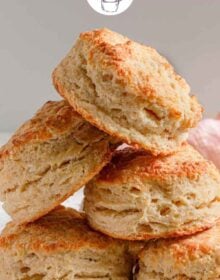



I have not tried the Buttermilk Biscuits yet but saw you suggested they can be frozen before baking. Do the biscuits need to be defrosted before baking if the are frozen and then baked 10-15 minutes? Or can you bake them while they are still frozen? If so, how long?
Hi Anne, You can bake straight from frozen, they may just need an extra few minutes.
I will try these at home.
hello Brown Eyed Baker I’m wondering for biscuits buttermilk biscuits or angel biscuits instead of baking powder or baking soda or combinations thereof can I just add in a package of yeast thank you
Hi Glen, I’ve never made angel biscuits, but for these biscuits I do not recommend using yeast.
Hello Michelle :) Has the amount of baking soda in this recipe changed as of 3/27/2019? Is it still actually 2 tablespoons of baking powder? I noticed several comments questioning the amount of baking soda. Thanks for answering this.
I updated this recipe in June of 2018, no changes made since then.
I’m guessing those commenters used 2 tbsp baking SODA, not baking POWDER. Soda should be substituted for powder of about a 1-to-3 ratio–that is, two TEASPOONS of SODA.
I made the same mistake the first time I made these… I salvaged it by drinking a lot of fruit juice at the same time as I ate the biscuits, which made for fizzy juice rather than bitter biscuits.
The recipe as written is perfect, though. I’m addicted to these biscuits.
I have used this recipe 3x now, and I use the 2 Tablespoons. It’s wonderful! I read one review on this where someone said they were bitter, but not one person from my family of 5 was anything less than ‘in awe’ of these biscuits. It’s truly the perfect buttermilk biscuit recipe!
These are spectacular! Very popular when I make them in our home. I’ve never made a batch to freeze and plan on trying that. Once I’ve decided to bake the frozen ones, do I need to thaw them first or bake from frozen?
Why do your older commentators mention using cake flour? Is this something you changed and if so, why?
Hi Lola, Yes, I completely revamped the recipe.
I made these for breakfast this morning and they were delicious! Tender and buttery and I could have eaten the whole tray. Baked up beautiful and tall. I was out of buttermilk so I used 1t of vinegar and enough milk to make the cup called for. Worked like a charm. These will be my go to biscuits from now on.
Made these last night and they were amazing!!! I’ve tried so many biscuit recipes, but I’ve just never been happy with the results.
These are my new favorite!!
A few things I did was, I grated in my freezing cold butter, and after I added the butter, I put my bowl into the freezer for a few minutes to make sure the butter mixture stayed cold.
Then I carefully rolled it into a rectangle and cut that into 12 squares, instead of cutting circles. I thought the less I messed with the dough, the better.
And, square biscuit tasted fabulous! Thanks, Michelle!!
These are very tasty and easy to make.
I agree these are very light and fluffy.
I hesitated when I followed the recipe. 2 tablespoons of baking powder? But I said, I need to follow her recipe. In all my days of baking (50+years) I have NEVER used even 1 tablespoon of baking powder in a recipe.
I was excited when they came out of the oven. One taste and I gagged with the bitterness of the baking powder. I hope this was a typo. Even 2 teaspoons seems like a lot.
Robert
After freezing unbaked biscuits, at what temperature and how long do they need to bake them? I baked some before putting the rest in the freezer and they were fantastic! My new favorite recipe!
Hi Linda, I would bake at 475 for 5 minutes, then reduce to 425 and bake for another 10 minutes or so, until golden brown. I’m so glad you enjoyed them!
So delicious, best home made biscuits I’ve ever made, and easy!
These look amazing!
Question…Do i have to alter the recipe for high altitude?
Hi Maida, I’ve never made these at altitude, so I cannot say for sure, but this is a great resource guide for what you may need to adjust: https://www.browneyedbaker.com/high-altitude-baking-tips/
I thought that you need baking soda and baking powder when using an acid liquid like buttermilk
Hi John, Baking powder is actually made up of baking soda + cream of tartar, and sometimes cornstarch. So you’ll still get a reaction/rise from from the buttermilk!
These biscuits look dandy! I noticed there was no baking soda used? Most recipes I’ve dealt with that use buttermilk calls/requires for some baking soda to be added.
Hi Mack, That’s true, although it’s not necessary. Baking powder is actually made up of baking soda + cream of tartar, and sometimes cornstarch. So you’ll still get a reaction/rise from from the buttermilk!
Made these today, so easy, tasty, buttery, and my dogs loved the scraps. Thank you!!
Followed this recipe today and produced tasty biscuits. Very easy to follow and my biscuits looked good and tasted great. Thanks.
If I freeze before baking, should I thaw completely or maybe bake partially frozen for more rise?
Hi Anne, No need to thaw, you can bake from frozen, just add a couple of minutes!
I can’t wait to make these. I’m never good at “cutting in” the butter with a pastry blender, so when making scones I would freeze the stick of butter and grate it. I could then mix it in with a fork and get the right consistency. Works every time for me so I will try that with this recipe!
Congrats on your growing family! Love seeing the pics of your adorable kids and your goldens! We have a 9 year old golden, Zoe.
Can you use dry buttermilk reconstituted?
I add the buttermilk powder with the dry ingredients then use water when you would use buttermilk. I love that I always have it on hand, I just store it in the frig after opening.
Hi Cathleen, I haven’t, but love Mary’s tip below!
I use Buttermilk powder for baking and absolutely want King Arthur unbleached cake flour when cake flour is called for.
Have you ever used the powdered buttermilk? I use it for pancakes, but not sure what else to use it in.
Hi Jan, I have not!
I store my unsalted butter in the freezer. For biscuits, I grate the frozen butter into my bowl of flour and proceed as directed. Easy peasy!
Hi Michelle, I use a flat grater and butter from the fridge then just stir gently with hands if needed I put the whole load of dry ingredients in the freezer…more flakes of butter I’m with you on all the other tips…they’ve made mine incredible!
Thanks so much for the tip!
I always keep a tin of powdered buttermilk in the fridge. I can’t stand the taste of it so won’t drink it straight, but I can’t deny buttermilk’s necessity when baking some things. The powdered lets me only prepare what I need when I need it. And at ~$5 a tin, it’s very economical as well! Can’t wait to try this recipe, as biscuits are one of my favorite things on the planet as well!
I’m confused reading the comments – referrals as to different types of flour and the reference to this being a recipe from America’s Test Kitchen. What am I missing in this posting?
Hello! So sorry for the confusion – I originally published this post nearly 10 years ago, but have re-worked the recipe and re-published it this week. I will add a note to keep confusion at bay!
I agree – I always have sky high expectations for biscuits, but so many are meh. I want the layers to be as high as my expectations I guess, hehe. Appreciate the cold butter trick and can’t wait to try these!
Just out of the oven and fabulous. Best recipe I have ever tried for biscuits. Thank you so much for all the tweeking to get it perfect for the rest of us.
Hi Susan, Yay! I am so thrilled to hear that!
I just tried making biscuits from scratch and they tasted great but didn’t have quite the airy, light texture and high rise I was hoping to get. Your tips are all helpful and probably the reason mine didn’t turn out quite right. Thanks for sharing!!
I’m confused a bit . . . . reading through the reviews, I’m seeing some that talk about a combination of flours, some that say cake flour, and yet the recipe says all purpose flour . . . . HELP! I want my biscuits to look like yours (have yet to achieve that goal), so getting the flour(s) right is important. Also, was wondering if you have ever used White Lily flour for your biscuits. The biscuits you made look fantastic, and now with strawberries just coming into season (just yesterday bought 2 qts from the local farmer’s market) I need to . . . must . . . make these ASAP :)) Hope you’re doing well.
I noticed that too, reading through the reviews. I use AP flour (organic) for my biscuits. Works great! And, if using biscuits to serve Strawberry Shortcake-style, like another reviewer said, increase the sugar from teaspoons to tablespoons. I loved the biscuit in place of cake for strawberry shortcake!
Hi Michelle, This is a recipe that I posted nearly 10 years ago, but totally reworked and re-published this week. I’ve never used White Lily flour!